If you’re not bringing in as many leads as you’d like, your Cost per Lead (CPL) is too high, or your leads aren’t qualified, it’s time to reassess your B2B marketing and sales funnel.
Don’t have a funnel? Then it’s time to make one to help improve your marketing strategy!
Difference Between B2B and B2C Funnels
A common mistake when creating a B2B marketing funnel or a B2B sales funnel is following the outline of a B2C marketing funnel or direct-to-consumer conversion funnel.
A B2B marketing funnel and a B2B sales funnel differ from other business types like a B2C funnel because the cost of the product or service tends to be higher. There are also differences in other areas, such as long-term versus short-term goals, sales cycle length, and more.

Source: WordStream
Even in instances where the cost is low, there will need to be a stakeholder buy-in beyond the individual employee shopping around.
This means the B2B customer journey is long; the account-based marketing and sales funnel need to account for this.
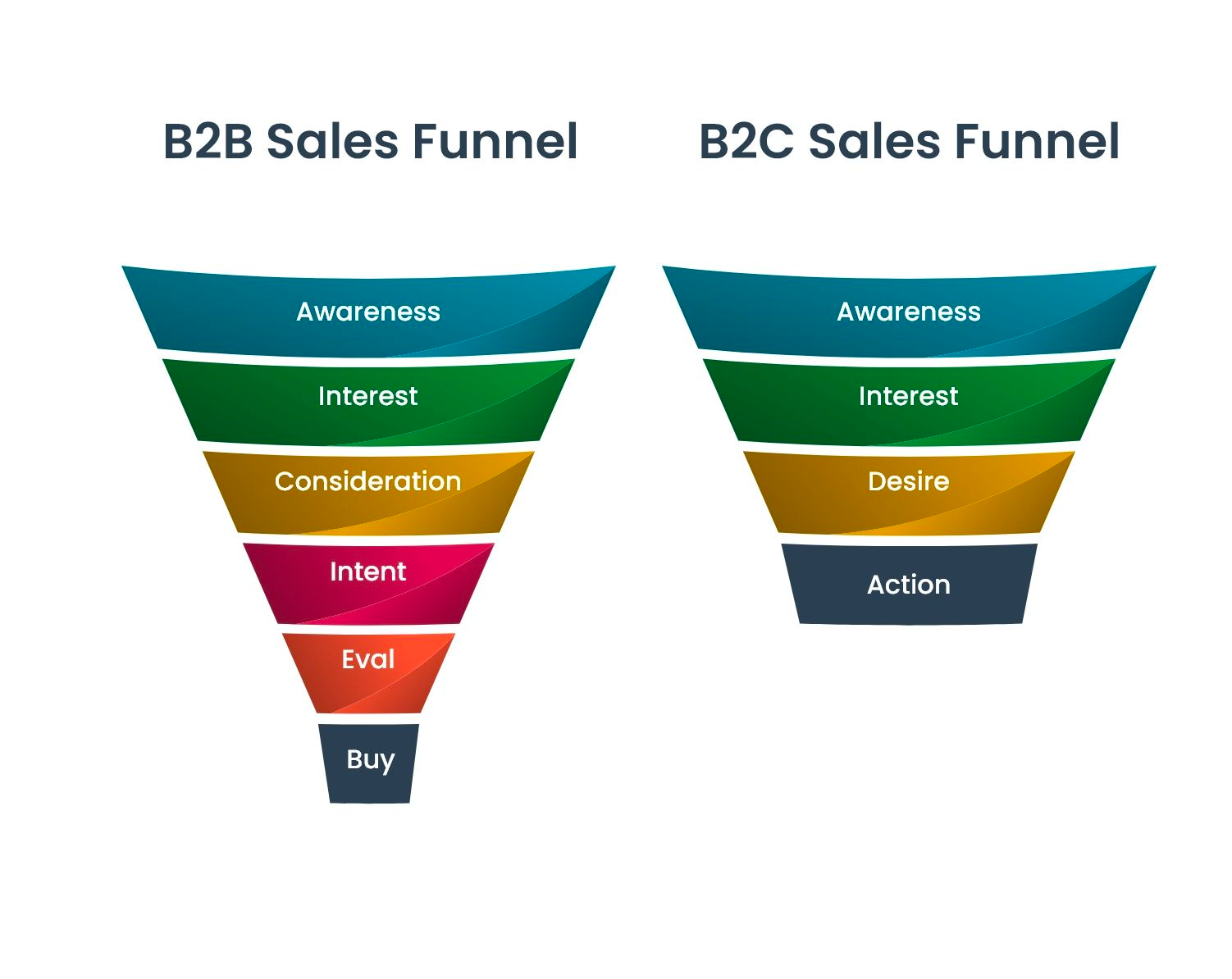 Source: Pepper Cloud
Source: Pepper Cloud
B2B Marketing Funnel Stages
When building out a B2B marketing funnel and a B2B sales funnel, we need to start by laying the foundation.
This means deciding what funnel stages to include and which customer journey analytics or KPIs are important to look at in order to determine if the stage is doing its job correctly.
Stage 1: Awareness
The Awareness stage is the B2B digital marketing efforts needed to drive new prospects of your target audience to your website and build brand awareness.
Then, once on your website, the site needs to introduce these prospects to your high-level value proposition for both demand generation and lead generation purposes to fill your sales pipeline.
Payroll solutions company, Gusto, is a good example of a brand that wins at the brand awareness stage, as they provide a crystal-clear value proposition with their B2B content.
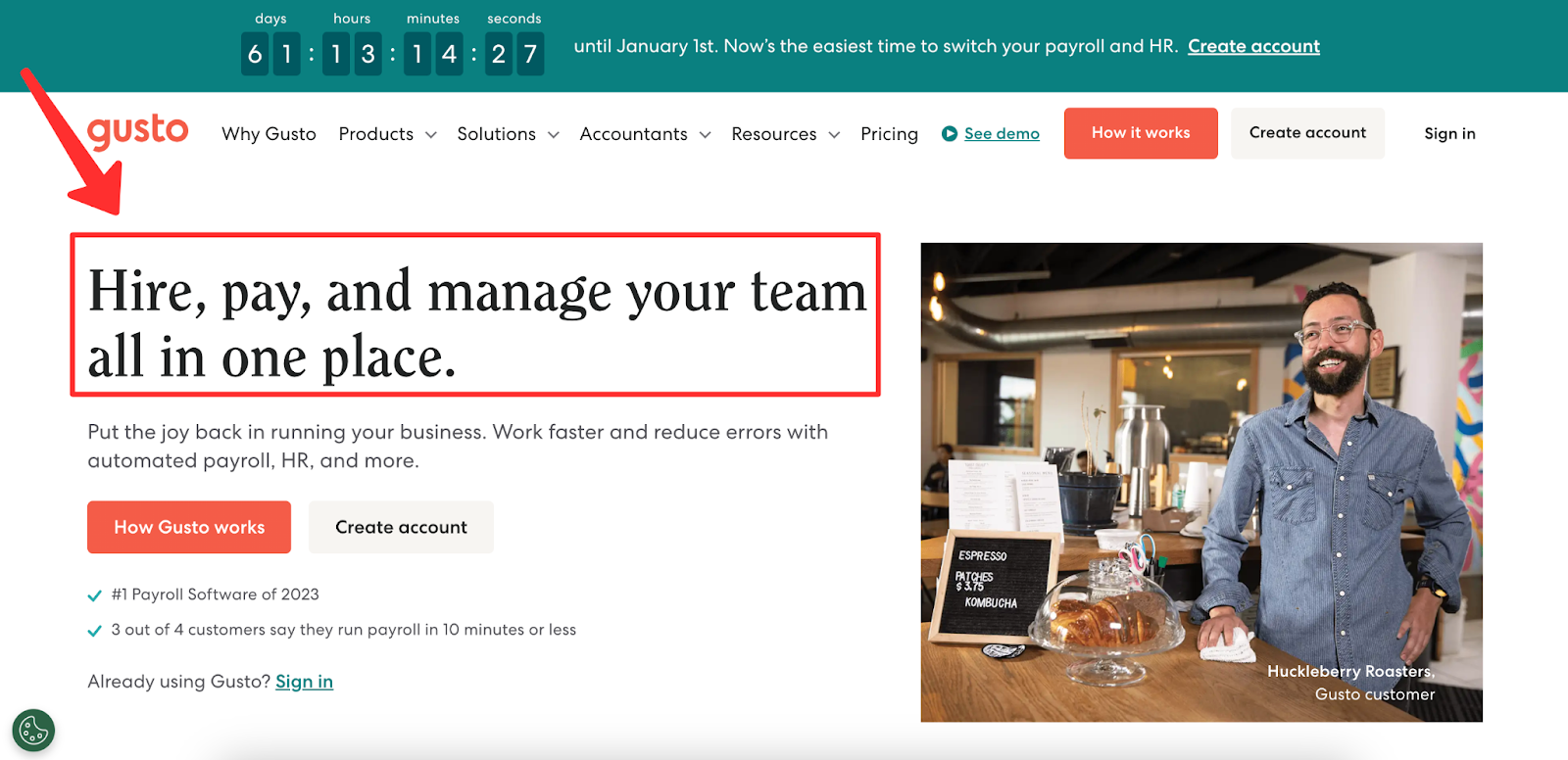
Because we know that most B2B purchases are not made on a whim, there also needs to be a content funnel to get potential customers to raise their hands and say “I want more information” while they are on your website.
Here are key actions that should happen in this phase:
- A potential customer enters your website
- Watches your pre-recorded demo
- Follows on at least one social media channel
- Signs up for a webinar or downloads content (eBook, guide, etc.)
- Gets automatically added to an email nurture campaign
HubSpot is the king of encouraging prospects to sign up for freebies…
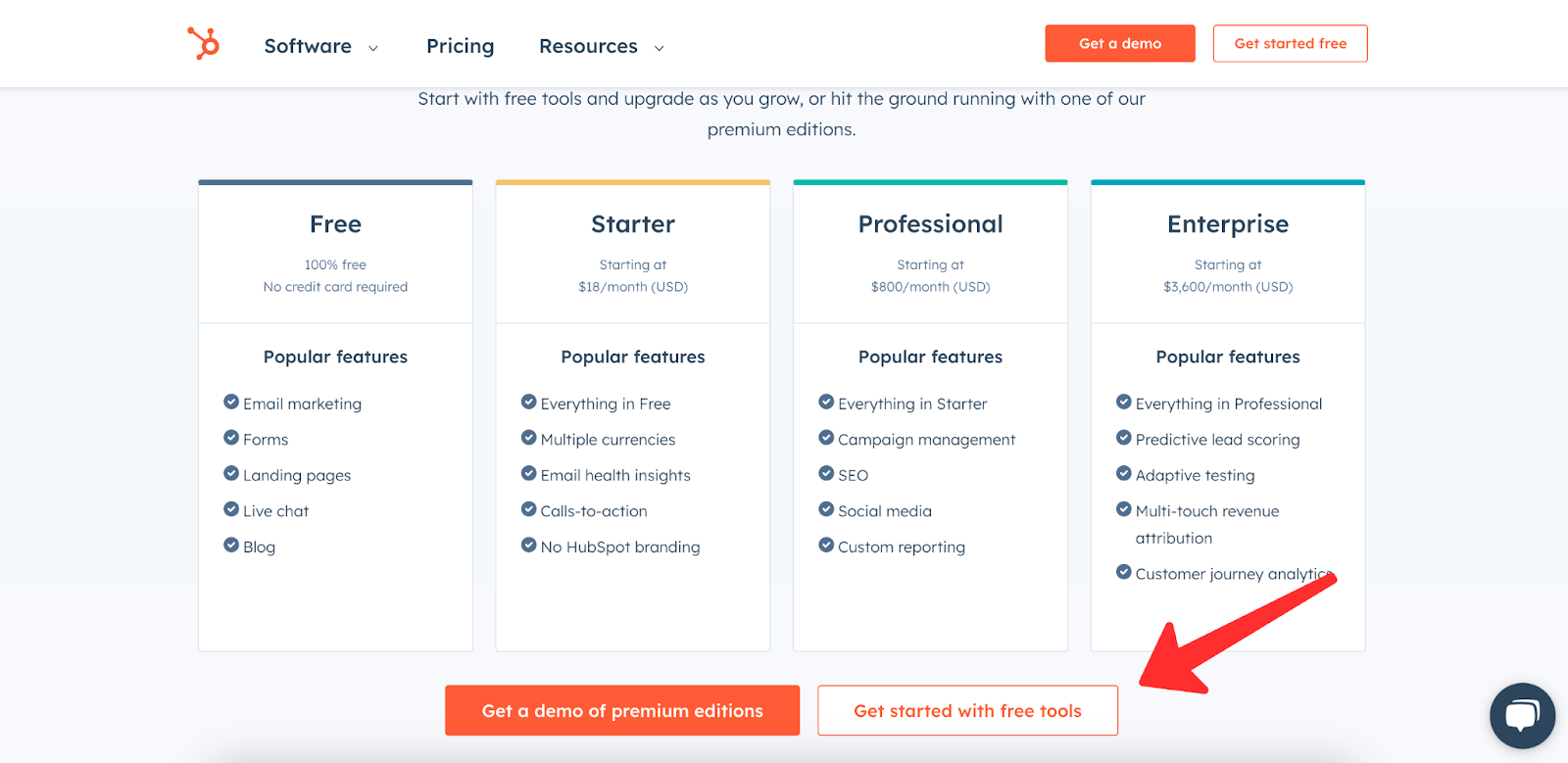
…in exchange for contact information that can be used for nurturing and building brand awareness.
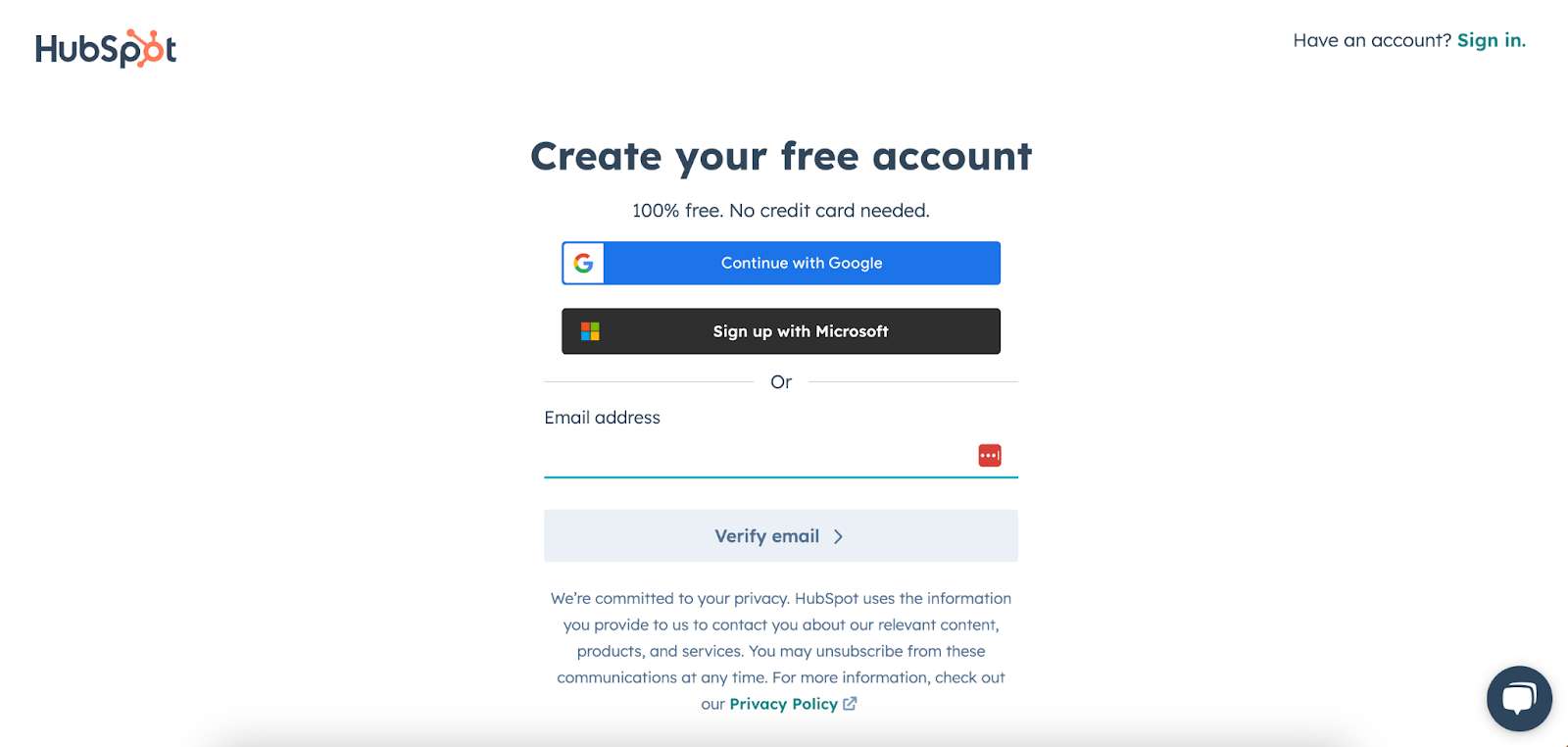
To know if you have any leaks in the awareness stage of your B2B marketing funnel you should be looking at these KPIs:
- Number of new visitors to the site
- Growth of social media channels
- Number of new email subscribers
- The conversion rate for gated content (webinar, downloadable)
Once you’re tracking these KPIs you’ll be able to quickly identify any underperformers in your inbound marketing efforts.
Once you know which metrics are underperforming, you can start testing new ideas to improve the results.
For example, if you’re not getting many new visitors to your site, you know you need to look at your marketing channels, run more ads, or improve your ads to achieve a higher click-through rate.
Similarly, if you’re getting a lot of traffic to your website, but your conversion rate for gated B2B content marketing pieces is low, then you need to create an offer that resonates better with your prospects.
Getting your awareness stage working properly is key to making the rest of the marketing funnel produce great results.
If you’re not driving enough of the right prospects to the top of your sales funnel, you can’t expect to see a lot of people become paying customers.
Stage 2: Consideration
Once you have a steady flow of interested prospects that fit your ideal buyer persona entering the top of your funnel, they move into the consideration stage.
This is where the B2B buyer weighs the pros and cons of using or servicing your product over the competition.
Here are key actions that should happen in the consideration stage:
- Potential customer starts receiving automated emails
- Opens emails to learn more about features/benefits
- Clicks emails to read more information on the site
- Product comparisons
- Detailed pricing information
- Signs up for a free trial or demo
- Optional - Responds to feedback survey about why he/she didn’t sign up for a free trial or demo if applicable.
Gusto succeeds here again with this resource that allows leads to compare their B2B company side-by-side with other competitors.
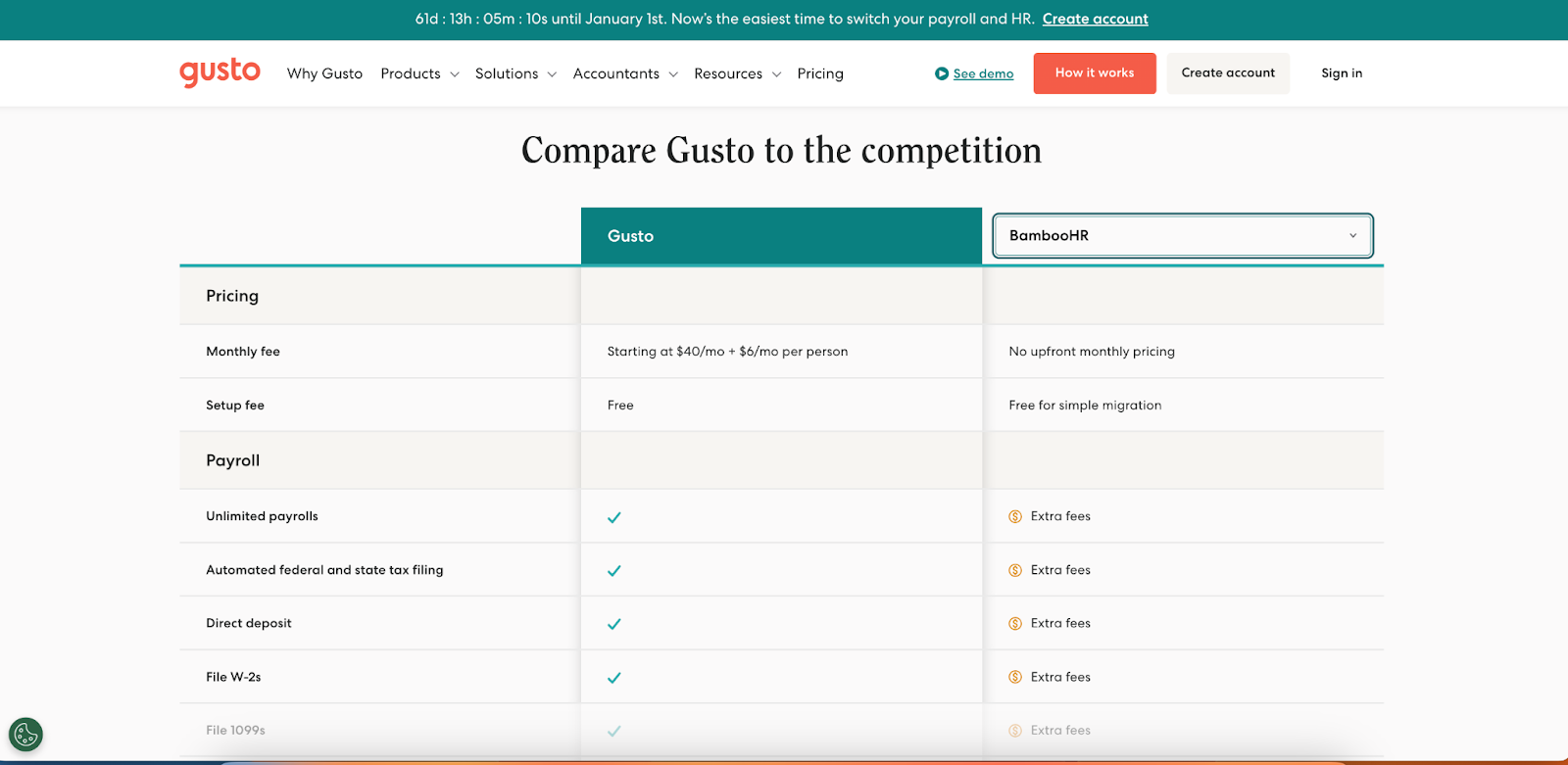
To know if you have any leaks in the consideration stage of your marketing funnel, you should be looking at these KPIs:
- Email open rate
- Email click-through rate
- Target audience engagement with informative content on the website
- The conversion rate for a free trial or demo sign up
If you’re seeing many prospects come in through the consideration stage of your funnel, your email list should be growing nicely.
Once on your email list, your content marketing pieces should nurture the buyer into better understanding your offer.
Here’s another good example from Gusto.
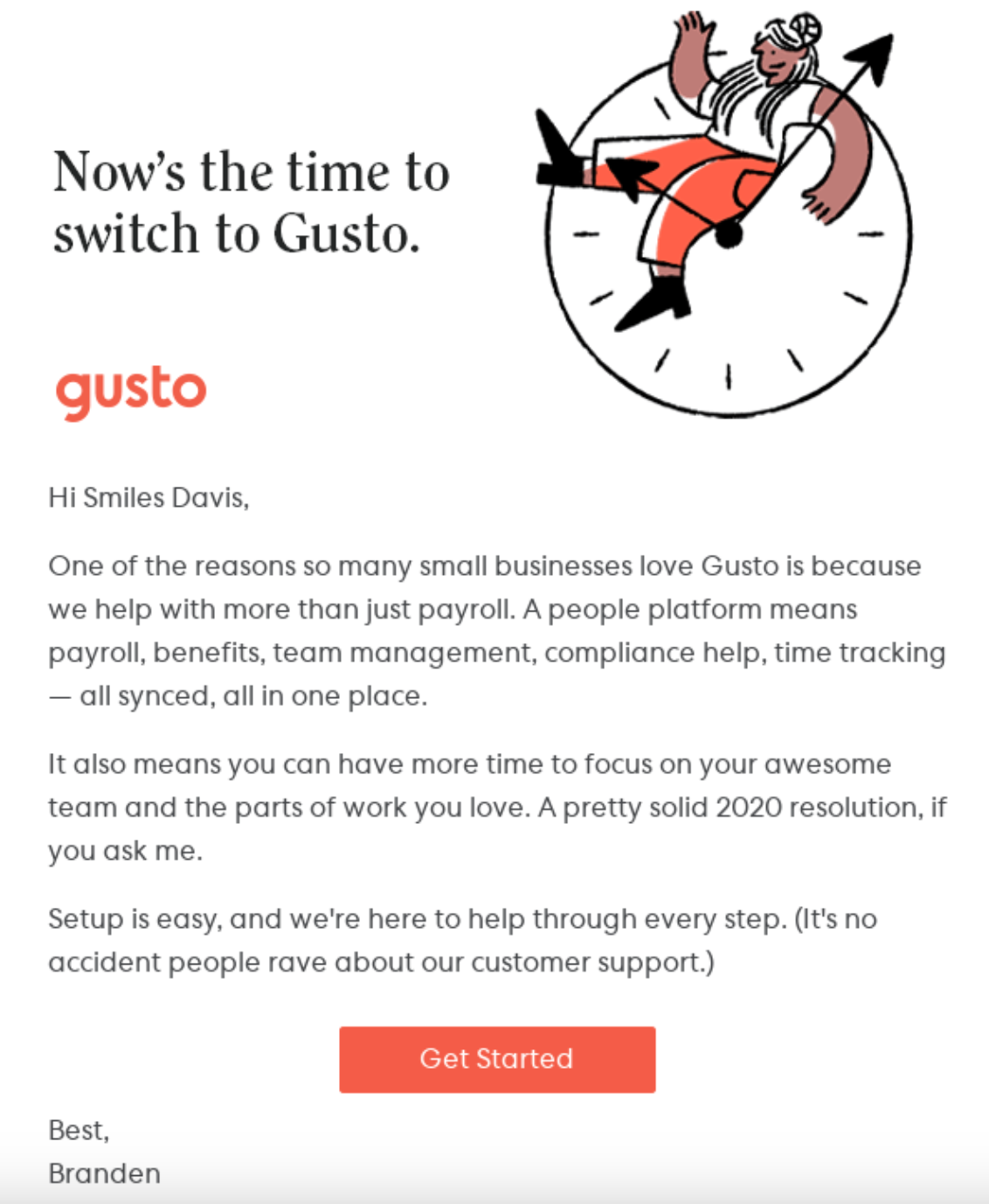 Source: Really Good Emails
Source: Really Good Emails
If the potential buyer is not engaging with your emails, you’ll know you need to evaluate the messaging you’re using.
For example, if your open rate is low, you’ll need to test different subject lines, and if your click-through rate is low, you’ll need to test stronger calls-to-action and/or offers.
If prospects are opening and clicking through to your site but aren’t signing up for your demo or free trial, then you need to identify why.
This can be done by sending a short feedback survey to someone who goes through your entire email drip campaign but doesn’t convert.
A single question with multiple answers might say:
- Why did you decide not to move forward at this time?
- Pricing is out of budget right now
- Decided to try a different company
- Still interested, but need more information
- Need help getting stakeholder buy-in
- Other- fill in the blank
Once you start collecting data on why prospects are not converting, you can begin to address these concerns in your content strategy messaging to improve your conversion rate.
If you find that people don’t respond to your request for feedback, you’ll need to test different messaging out and see what people respond to best.
For instance, if you think the pricing is a concern for your target audience, you can offer a special discount if the company closes before the end of the current quarter.
Similarly, if you think stakeholder buy-in is an issue, you can start producing B2B content marketing funnel pieces such as blog posts or landing pages that will help your lead get that buy-in for the purchasing decision.
Stage 3: Evaluation
The evaluation phase of your B2B marketing funnel and B2B sales funnel is key.
While the first couple of phases are squarely on the shoulders of the marketing team, here is where coordination with your product and sales teams comes into play.
Here are key actions that should happen in this phase:
- Download a software trial or attend the demo
- Install/sign up for trial software
- Receives automated nurture email marketing content to drive toward the purchase
- Clicks emails to read more information
- Current sales promotions
- Competitive advantages
- Key benefits
- Identify hot leads to the surface sales team
- Optional- Responds to feedback survey about what he/she likes and doesn’t like about the software or service.
Here’s an example of enterprise resilience B2B SaaS company Splunk offering a free trial to streamline the evaluation stage.
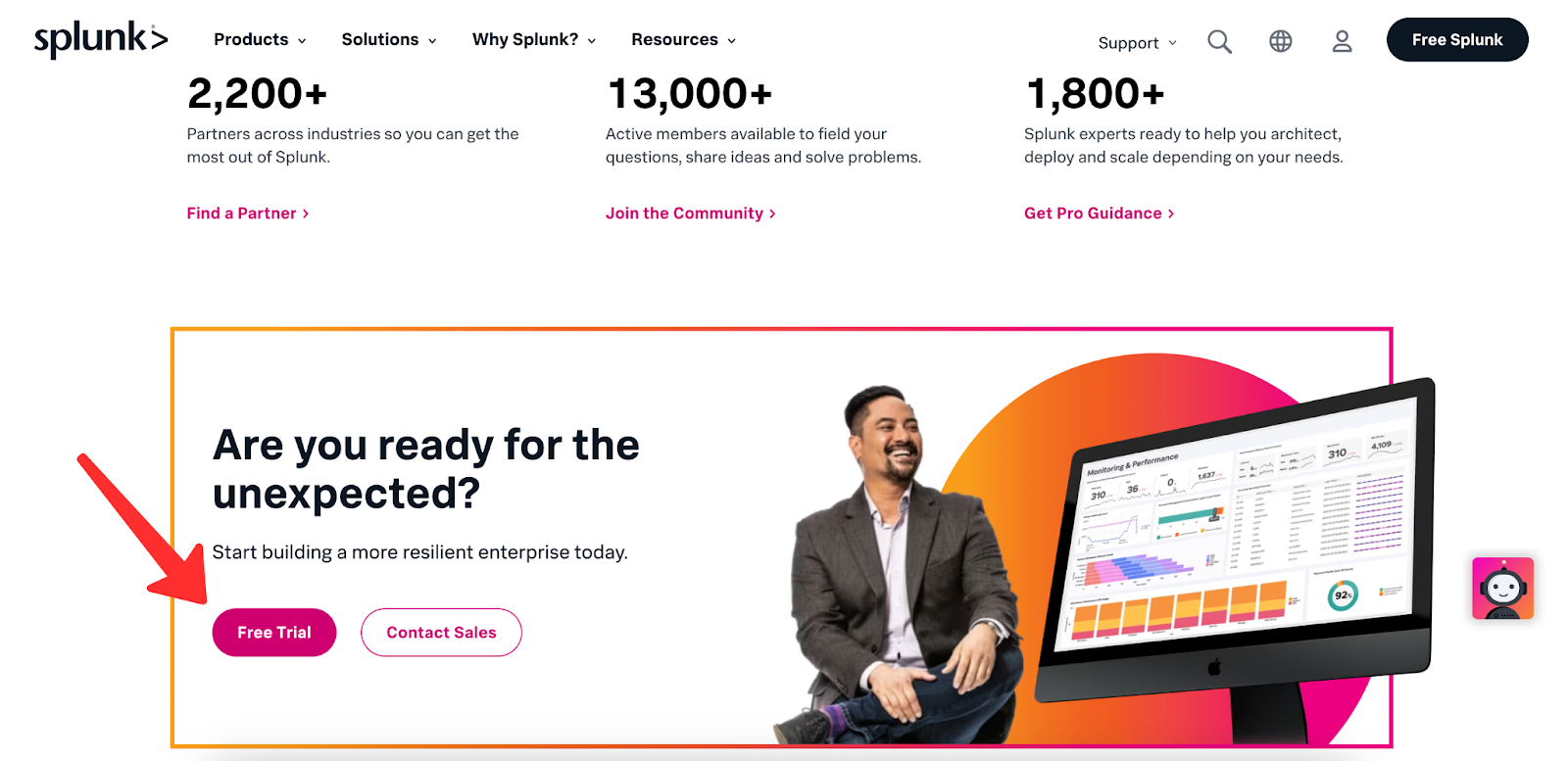
To know if you have any leaks in the evaluation stage of your marketing funnel, you should be looking at these KPIs:
- The conversion rate for installing trial software or attending the demo
- The conversion rate for completing setup and using software
- Engagement between a marketing-qualified lead and a sales rep
At this point, your marketing efforts have gotten your lead to the point that they are ready to try your product or service - now the sales process kicks in.
Whether the lead moves on to purchase or not depends on if what you have to offer works well and is a great fit.
If you find that a lot of leads install your trial but don’t go on to use the product (aka they abandon the trial), it’s time to dive in with your product team to find out why the customer experience is less than ideal.
You can do this by surveying your leads and asking them why they didn’t end up using their free trial, but only a portion of people are likely to respond.
It’s up to you and the product team to look at your product analytics and see where most people fall off.
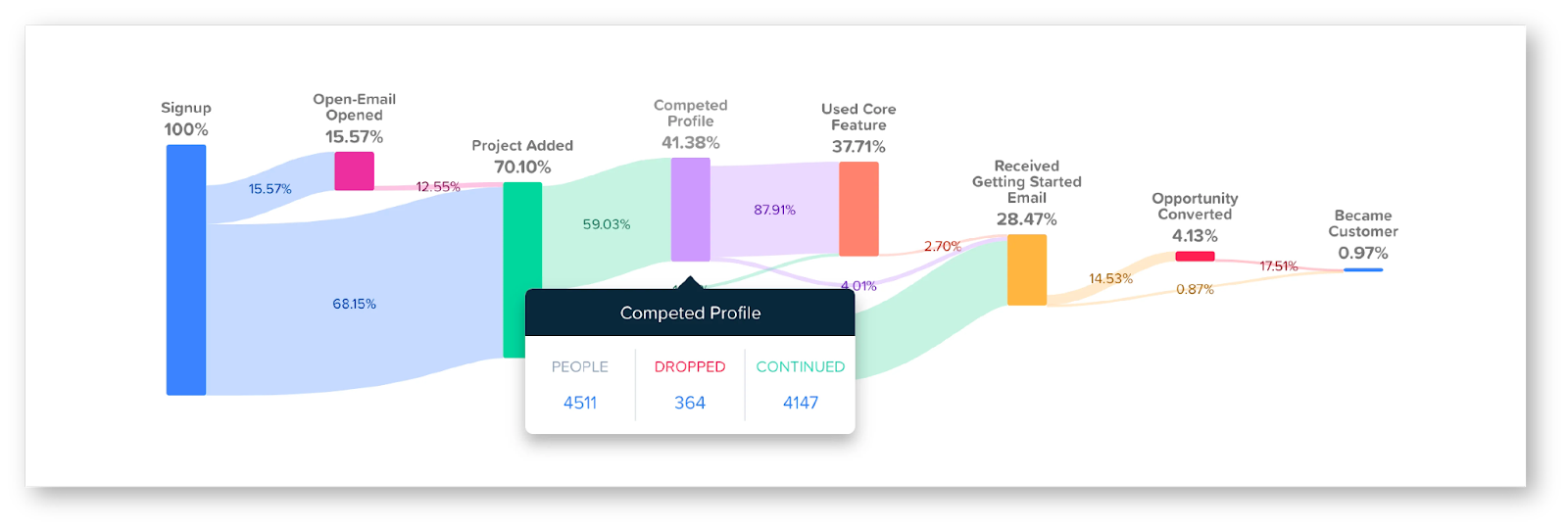
There could be a particular interface or feature that is not as user-friendly as it could be that needs to be fixed.
Similarly, if you are getting many people to raise their hands and sign up for a live demo, your sales team should be asking for feedback.
What do you like about the software/service? Is there anything you think we should add or that isn’t necessary? Does anything seem confusing?
At this stage, you’ve got the lead almost to the finish line, and your product and sales team are your reinforcements.
Together, the three of you need to make sure the offering is the best it can be to move people through the evaluation phase in a positive way to get the B2B sale.
Optimize for Conversion & ROAS Now! Explore Woopra in a demo and enjoy a 2-week free trial: https://www.woopra.com/demo
Stage 4: Action
Now we’re at the fun part - the action stage of the B2B marketing funnel! Here is where your hot leads should be converting into new customers.
Here are key actions that should happen in this phase:
- Purchase
- Onboarding
- Start a new customer nurture campaign
- Engage upsell/cross-sell campaign
- Renew/increase contract
- Send customer satisfaction survey
To know if you have any leaks in the action stage of your content B2B marketing funnel, you should be looking at these KPIs:
- The conversion rate for the initial purchase
- Customer satisfaction during onboarding
- Engagement with new customer nurture campaign
- The conversion rate for upsell/cross-sell campaigns
- The conversion rate for contract renewal
While your account service team will likely take over the onboarding phase, the marketing work is not done just because the sale is closed.
The acquisition marketing may be complete, but the account-based marketing is just beginning. In this phase, your marketing efforts need to focus on customer analytics to support your accounts team.
At this funnel stage, you should be using your marketing automation software to send emails with tips and advice on how to get started easily.
You should also have timed out emails ready to go to help your account management and sales teams upsell and cross-sell once the existing customer is onboarded.
Here’s a good example from Zoom where they use email marketing to offer users 30% off the first year by signing up for their Pro Annual plan.
 Source: Really Good Emails
Source: Really Good Emails
Lastly, you’ll need a marketing campaign to support the renewal portion of the sales cycle.
These can include emails and social media posts that remind the customer of all the reasons your software helps his or her business produce better results.
Also be sure to talk about new, upcoming features!
Stage 5: Re-Engagement
Remember those leads who self-identified as not having the budget or not being able to get stakeholder buy-in previously?
Those leads are still interested in your service and just need time to get to the place where they can become customers.
That’s why a re-engagement campaign is important for lead nurturing - don’t go dark on these potential customers!
Here are key actions that should happen in this phase:
- Start receiving automated re-engagement email marketing messages
- Opens emails with an irresistible offer
- Clicks email to learn more about offers
- Engages with CTA to speak with a sales rep about an offer
- Signs up for offer
- Or does not sign up but re-engagees and gets moved to nurture email flow
Grammarly does a great job of re-engaging subscribers with this amazing offer of 50% off any plan.
 Source: Really Good Emails
Source: Really Good Emails
To know if you have any leaks in the re-engagement stage of your marketing funnel, you should be looking at these KPIs:
- Email open rate
- Email click-through rate
- The conversion rate for an irresistible offer
- Engagement with nurture content
To make the re-engagement campaign really work, you’ll want to have an irresistible offer for the lead to opt in to.
Why go all out for these leads? You already know they are interested, and if you can really WOW them, you can help them make the deal they already want to make with you.
If you don’t see any engagement with this campaign, keep trying new offers. These are leads that want to close and just need a little push to get over the hill.
As a B2B marketer, it’s your job to try and convert hot leads into customers and warm leads into hot leads - don’t miss this key step.
How to Build a B2B Marketing Funnel
Now that you know all about B2B marketing funnels and sales funnels, as well as the different stages and which KPIs to keep track of, it’s time to build your funnel.
One of the easiest ways to make your traditional B2B marketing funnel content outline is in an Excel or Google Spreadsheet.
Here is an example of a marketing and sales funnel I made for a B2B software company:
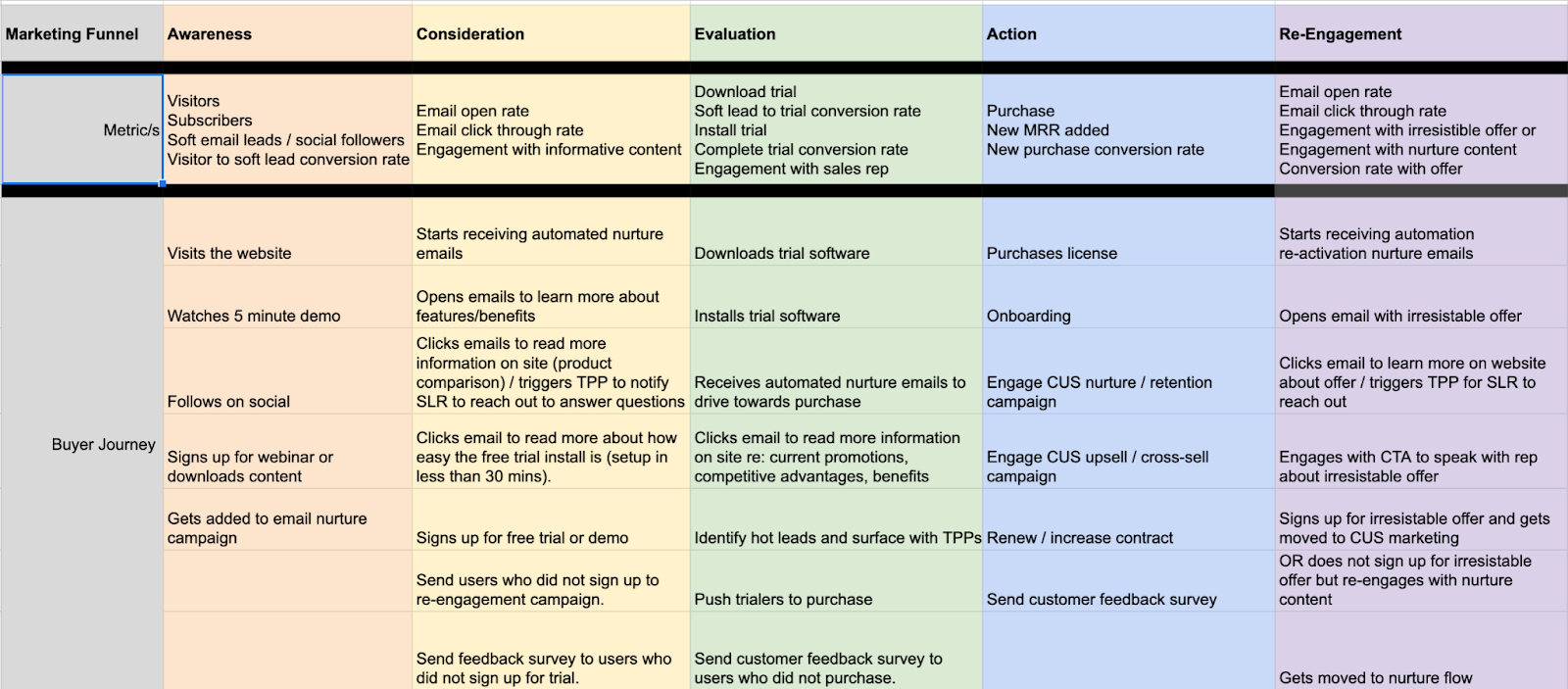
I can quickly see all of my key metrics and the actions that I need buyers to take.
The Buyer Journey actions lay out the marketing tasks I need to create.
For example, in the Consideration Phase of the B2B funnel, I need potential buyers to engage with informational emails, so I know I need to create those emails and set up the email workflow.
Using this outline to create your own B2B marketing and sales funnel should take you just about an hour. From there, the real work begins to launch your funnel marketing activities!



